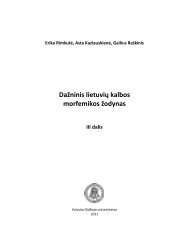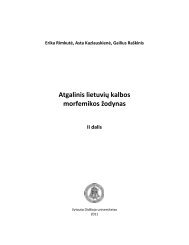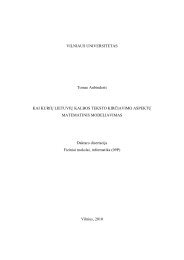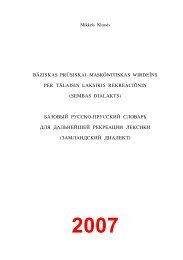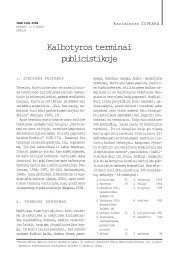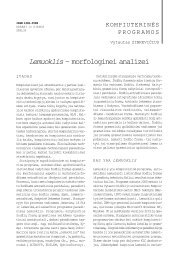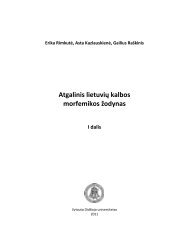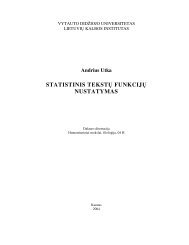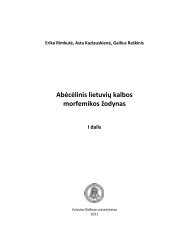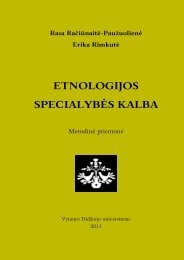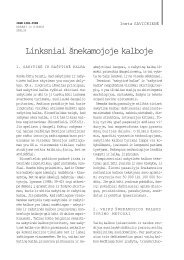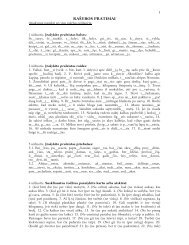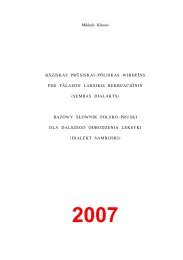HISTORICAL GRAMMAR OF OLD PRUSSIAN
HISTORICAL GRAMMAR OF OLD PRUSSIAN
HISTORICAL GRAMMAR OF OLD PRUSSIAN
You also want an ePaper? Increase the reach of your titles
YUMPU automatically turns print PDFs into web optimized ePapers that Google loves.
86<br />
V. Maþiulis<br />
* 212. Note. 1 pers. pl. giwammai, l`ikumai, turrimai etc., 2 pers.<br />
pl. turriti etc., beside 3 pers. giwa, l`iku etc., could be comprehended as if<br />
derived from the 3rd person. Due to this reason such innovations could<br />
arise as 1 pers. pl. wîrstmai ‘we become’ (: 3 pers. wîrst), dînkaumai ‘we<br />
thank’, massimai ‘we can’ (: 3 pers. massi), grîkimai ‘we sin’ (: 3 pers.<br />
grîki-si), schlûsimai ‘we serve’, waiti`mai ‘we speak’ (: 3 pers. en-waitia),<br />
druwçmai ‘we believe’ (: 3 pers. druwç), seggçmai ‘we do’ (: 3 pers. seggç),<br />
etwçrpimai ‘we forgive’ (: 1 pers. = 3 pers. etwerpe), girrimai ‘we praise’<br />
etc.; cf. Endzelîns SV 106 .<br />
Tense and mood<br />
* 213. In the language of the Catechisms present, past and future<br />
tenses are attested, as well as 2 numbers: singular and plural. The form of<br />
the 3rd person is often used in the meaning of the 1st and the 2nd person<br />
in singular, e.g.: as drowe (I), es drowy (II), as druwç (III) ‘I believe’,<br />
thou tur (I), tou tur (II) ‘thou shalt’. This seems to be a fault of translators<br />
(Endzelîns SV 102 f.), but possibly not only theirs (cf. Maþiulis Baltistica<br />
I Priedas, 95–100). An authentic form of the 1st person is that of the verb<br />
‘to be’ (see * 205 ff.); for 2 sg. -si, -sei, -sai see * 208 94 .<br />
94 Having in mind Prussian and Slavic isomorphism (cf. ftn. 79), one really could expect an<br />
inflection 2 sg. *-sei, ‘borrowed’ from the athematic paradigm, as this possibly took place in<br />
Slavic (*-sei, not the “primary” *-si!). However forms without this -sei (cf. gîwu III 85 14 beside<br />
gîwasi III 95 3 ) are also attested. What “translators” could then make such terrible mistakes? Who<br />
can believe that priest Abel Will did not know how to say corresponding verbs in the 2nd person<br />
or even in the 1st person singular? The formulas of Matrimony As imma ti[e]n III 107 15 ‘I take<br />
thee’, and of Baptism As Crixtia tien III 129 10 ‘I baptize thee’, were used by priests throughout all<br />
Prusa (Baltic Prussia), first translated by native-speaking “tolkers”. Such “tolker” was also Paul<br />
Megott, helper of A. Will (P. Megott could not made primitive mistakes but A. Will was a translator,<br />
not “translators”). No doubt, 1st sg. (as if the 3rd person) imma, crixtia are authentic forms.<br />
In referred article (Baltistica I Priedas 101) V. Maþiulis says: “when in occasional instances an<br />
athematic -s(e)i was added, arose Pr. 2 sg. -a + s(e)i > -a-s(e)i, cf. Pr. giw-a-ssi”. An<br />
explanation of Pr. 1 sg. (as if the 3rd person) -a is given by V. Maþiulis in BS 22: this was<br />
regular ending of barytone verbs, in which Balt. 1 sg. *-ô > Pr. *-¯É > Pr. (Cat.) > -a. As in other<br />
instances, barytone, not oxytone, allomorphs were generalized in Prussian. Thus the a-stem<br />
form of the 1st person in singular was identic with that of the 3rd person in the `-stem present<br />
and in the `-stem preterite. This supported the a-stem 3 pers. pr. *- ‹a after the shortening of the<br />
final vowels and prevented the latter from disappearing. As a result, wide processes of neutralization<br />
and decline of inflectional oppositions between persons and tenses took place in the<br />
said dialects. A need of analytism appeared (cf. www.eidem.lt/dialangn.htm). Cf. also ftn.<br />
114. – L.P.



